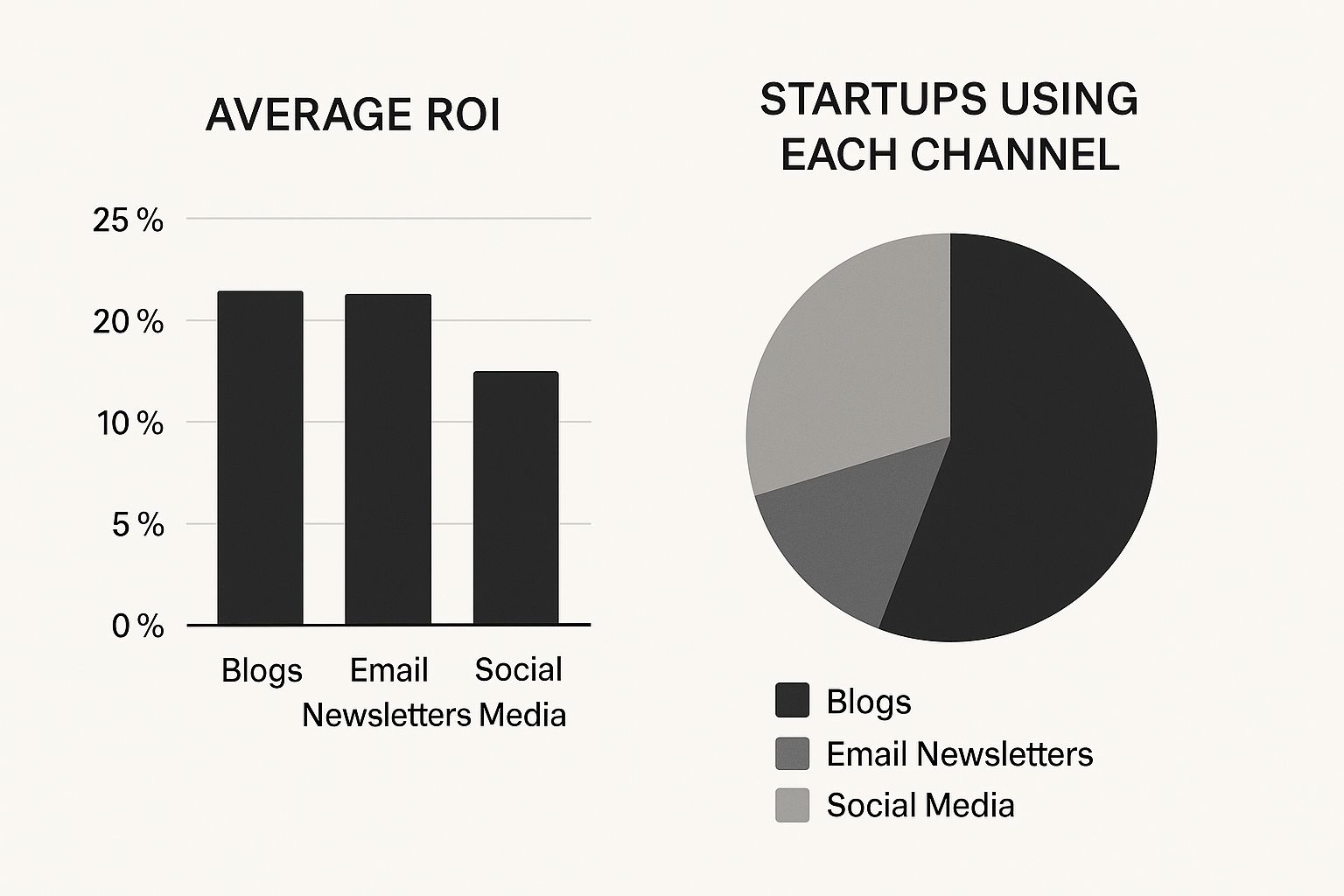
Content Marketing for Startups: A Founder's Essential Guide
Discover expert tips on content marketing for startups to boost your growth. Learn proven strategies to attract and retain your target audience.
As a founder, you know the drill. You've poured everything into building a fantastic product, but now comes the hard part: getting people to notice you without a Fortune 500 marketing budget. This is where content marketing becomes your most powerful ally. It's not just about blogging; it's an engine for building trust, educating your future customers, and pulling in qualified leads—often at a fraction of the cost of paid ads.
Think of it as building an asset that grows with you, delivering sustainable results from day one.
Why Content Marketing Is a Startup's Secret Weapon
Every dollar and hour is precious in an early-stage company. While you could pour cash into flashy ad campaigns with unpredictable returns, content marketing plays the long game. It's an investment in an audience that genuinely trusts you, an asset that appreciates over time instead of vanishing the moment your ad budget dries up.
You're not interrupting potential customers; you're attracting them by solving their problems. This builds a kind of credibility that money just can't buy. It positions your startup not as another vendor shouting for attention, but as a go-to expert in your field.
The Real Value Hiding in Your Content
Good content marketing connects with people at every single stage of their journey. It's way more than just publishing articles. It's a strategic way of communicating that hits several critical goals at once:
- Builds Real Trust: When you consistently share valuable, non-salesy information, you establish your brand as a credible authority people can rely on.
- Generates Compounding Returns: A single, well-optimized blog post can keep attracting organic traffic and generating leads for years. That’s a return on investment that keeps on giving.
- Warms Up Your Market: Your content helps potential customers truly understand the problem you solve. By the time they're ready to buy, they're already educated and qualified.
A classic startup mistake is treating content like a short-term sales tool. Don't. Instead, think of it as building a library. This library educates your audience, fosters a community, and cements your brand as the expert. This mindset is the key to sustainable growth, not just quick, fleeting wins.
Before we go further, it's helpful to see what this looks like in practice. The core of a strong startup content strategy rests on a few key pillars.
Core Pillars of Startup Content Marketing
| Pillar | What It Means for a Startup | Key Action | | :--- | :--- | :--- | | Audience Focus | Go beyond demographics. Understand their real pains, questions, and goals. | Create detailed buyer personas based on research and interviews. | | Problem-Solving Content | Your content must offer real solutions, not just pitch your product. | Map content ideas directly to your audience's biggest challenges. | | Owned Media | Build on platforms you control, like your blog and email list. | Prioritize growing your email list from day one. | | Consistency | Sporadic posting won't build momentum. A regular cadence builds anticipation. | Develop a realistic editorial calendar and stick to it. |
Getting these pillars right from the start prevents wasted effort and sets you on a path to creating content that actually moves the needle.

This data paints a clear picture. While social media is a popular channel, owned media like blogs and email newsletters often pack a much stronger punch in terms of return. A smart mix is what truly defines effective content marketing for startups.
The market trends back this up completely. The global content marketing industry was valued at around $413.2 billion in 2022 and is on track to hit nearly $2 trillion by 2032. Why the massive jump? Because startups are realizing it's one of the best ways to build relationships and drive leads, far outperforming old-school advertising. You can check out more fascinating stats in this breakdown of content marketing trends.
If you're ready to get started, the first step is to nail the fundamentals. To give yourself a head start, you can explore our detailed guide on content marketing best practices.
Finding Your Audience and Your Unique Angle

Let's get one thing straight: effective content marketing doesn't start with writing. It starts with a deep, almost obsessive understanding of who you're talking to. Forget generic demographics like "males aged 25-40"—that’s a surefire way to create content that speaks to absolutely no one.
You need to know their real problems. The actual language they use. What keeps them up at night.
Without that clarity, you’re just shouting into the void. But with it, every single piece of content you create acts like a magnet, pulling the right people into your world and building a solid foundation of trust. This isn't just some box-ticking exercise; it's the bedrock of your entire content strategy.
Digging for Audience Gold
Real audience insight isn't hiding in a spreadsheet. You find it by getting out there and actively listening. The goal here is to move past assumptions and build a user persona so detailed it feels like you're describing a real person you know.
So, how do you start digging?
- Interview Your Ideal Customers: Get on a call with your first few users or the people you think are your perfect customers. Ask open-ended questions about their daily grind, what tools they can't live without, and where they go for information. Don't pitch. Just listen.
- Spy on Competitor Audiences: Go look at who’s engaging with your competitors. Read the comments on their blog posts and social media feeds. What questions pop up over and over? What are people complaining about? This is a goldmine of free, invaluable intel.
- Use Social Listening: Set up alerts for keywords and brand names in your industry on platforms like Reddit, LinkedIn, and X (formerly Twitter). You'll find completely unfiltered conversations about the exact pain points your startup is trying to solve.
These aren't just fuzzy activities; they provide the qualitative data that brings your audience to life. You’ll pick up on their specific vocabulary, their biggest headaches, and their goals—the raw material for content that actually resonates.
The best content ideas don't come from a brainstorm in a conference room. They come directly from your audience. When you hear the same question or complaint three times in customer interviews or on a forum, that’s not an anecdote—that's your next blog post.
Finding Your Unique Content Angle
Okay, so you know your audience inside and out. Now what? You need to figure out what makes your content different from the tidal wave of noise already out there. Another generic "Top 10 Tips" article just isn't going to move the needle.
Your unique angle is where your audience's biggest problem intersects with your startup's unique expertise.
To nail it down, ask yourself three critical questions:
- What common industry advice is just plain wrong? Challenging the status quo is one of the fastest ways to get noticed and position yourself as someone who actually knows what they're talking about.
- What proprietary data or unique experience do we have? Can you share insights from your own product data? A unique process your team developed? This is content nobody else can copy.
- What specific niche can we completely own? Instead of "marketing for small businesses," could you become the go-to resource for "marketing for independent coffee shops"? Getting hyper-specific attracts a much more dedicated—and convertible—audience.
This angle becomes the DNA of your content. It’s the common thread that ties everything together, making your brand instantly recognizable. For example, a fintech startup could own the angle of "demystifying complex financial topics for first-time founders," using simple analogies and a supportive voice. That’s worlds more powerful than just "writing about finance."
This is how you ensure your content marketing for startups doesn't just add to the noise, but carves out a distinct space you can dominate.
Choosing Your High-Impact Content Formats
Alright, you know who you’re talking to and what makes your startup special. Now for the fun part: deciding how you'll actually get your message out there.
Not all content formats are built the same, especially when you're a startup juggling a million things with a small team. The trick is to be surgical. Pick the formats that match your goals and, more importantly, are where your audience already hangs out.
Trying to be everywhere at once—blogging, shooting videos, recording podcasts, and posting on every social media platform—is a surefire way to burn out and get mediocre results. Instead, let's focus your energy on a few powerful formats that will give you the best bang for your buck.
The Foundation: Your Blog
Think of your blog as the heart of your content marketing. It's your home base. You own it, you control it, and it's not at the mercy of some algorithm change on a social platform that can kill your reach overnight. This is where you build real authority, pull in traffic from Google, and guide people toward your email list.
A single, great blog post can work for you for years. Seriously. A comprehensive guide that solves a major headache for your audience can rank on Google and bring in qualified traffic long after you hit publish.
For startups, a few post types work exceptionally well:
- Deep-Dive Guides: These are the big ones—2,000+ words that cover a topic from top to bottom. They scream "expert" and are magnets for backlinks and search traffic.
- Competitor Comparisons: Think "ViewPrinter vs. Competitor X" or "Best Tools for [Your Industry]." These posts grab people who are already in a buying mindset. They are pure gold for attracting bottom-of-funnel leads.
- Original Research & Data Stories: Got some unique data, even from a small customer survey? Use it. This is content no one else has, and it instantly positions you as a go-to source.
B2B Gold: Leveraging LinkedIn
If you’re a B2B startup, LinkedIn is more than just a place to post job openings—it’s a lead generation machine. This is where decision-makers and professionals go to learn and connect, making it the perfect spot for your content.
But just dropping a link to your latest blog post won’t do the trick. LinkedIn’s algorithm wants to keep people on the platform.
The smartest startups on LinkedIn treat it like a mini-blog. They share valuable text posts, insightful carousels, and short videos that offer real advice without always asking for a click. The goal is to build your brand and authority right there in the feed.
Focus on simple, text-only posts with actionable tips or short carousels that break down a complex idea. This strategy builds trust and keeps you top-of-mind with the exact people you want to reach. The numbers don't lie: 89% of B2B marketers use LinkedIn for lead generation, and an impressive 62% say it works.
The Undeniable Power of Visuals
In a world drowning in text, visuals cut through the noise. They're faster and easier for our brains to process, making them perfect for grabbing attention.
Two formats, in particular, are killer for startups:
- Infographics: These are perfect for turning data from your blog posts or research into a shareable, digestible visual.
- Short-Form Video: We’re talking TikTok, Instagram Reels, and YouTube Shorts. These quick, snappy videos are fantastic for showing the human side of your brand, demoing your product, or sharing a quick tip.
People are hungry for this stuff. Research shows that 83% of consumers want to see more video content from brands. And infographics? They aren't just 30 times more likely to be read than a plain text article; they can also boost website traffic by 12%.
These content marketing statistics tell a clear story: if you ignore visual content, you're leaving a huge amount of engagement on the table.
Ultimately, winning at content isn’t about doing everything. It’s about making smart choices. Start with a solid blog, amplify your message on a key channel like LinkedIn, and use visuals to stand out. This focused approach is both manageable and incredibly effective.
Building a Sustainable Content Creation Engine

Great ideas are everywhere. What really separates startups that succeed from those that just fizzle out is disciplined, consistent execution. Having a killer angle and picking the right content formats is a great start, but without a reliable system to turn those ideas into reality, your strategy is just a document collecting digital dust.
This is where you build your content engine. This isn't about becoming a content factory, churning out soulless, generic articles. It’s about creating a simple, repeatable process that lets a small team produce high-quality work, week in and week out. This system is your best defense against burnout and the only way to build real momentum.
The goal is to move from chaotic, last-minute scrambles to a predictable rhythm of creation. This is how you transform content marketing for startups from a string of one-off projects into a sustainable growth machine.
Crafting Your Editorial Calendar
Think of your editorial calendar as the beating heart of your content operation. It's where your big-picture strategy gets broken down into daily actions. Forget those overly complicated spreadsheets with a dozen tabs—a simple tool like Trello, Asana, or even a well-organized Notion board is all you need to get rolling.
The real magic happens when you can see your entire workflow at a glance. A Kanban-style board with columns like "Ideas," "Outlining," "Drafting," "Editing," and "Published" brings instant clarity. You immediately know what's in progress and what’s up next. This isn't just for staying organized; it's a powerful tool for keeping the whole team aligned.
Your editorial calendar shouldn't just be a schedule. Think of it as a strategic map. Each card on your board should represent a specific piece of content tied directly to a business goal, a target audience pain point, and a core topic pillar. This ensures every ounce of effort is purposeful.
For example, a Trello card for a new blog post might include:
- Title: A working title built around your target keyword.
- Target Audience: The specific persona this content is for.
- Core Problem: The single pain point this article solves.
- Keywords: Primary and secondary SEO keywords.
- Call-to-Action: What do you want the reader to do next?
This small amount of detail turns your calendar from a simple to-do list into a powerful strategic asset. It makes it obvious if you're leaning too heavily on one topic or completely ignoring a key stage of the buyer's journey.
From Ideas to Outlines
The leap from a good idea to a truly great article happens in the outlining phase. This is arguably the most critical step in creating content, yet it's the one most often skipped when teams are in a hurry. A solid outline is your blueprint, ensuring the final piece is structured, comprehensive, and actually says what you want it to say.
Start by brainstorming your topics in clusters. Instead of chasing random, one-off ideas, think in terms of pillars and spokes. If one of your content pillars is "SaaS Pricing Models," you could brainstorm a whole cluster of related articles:
- Pillar Page: The Complete Guide to SaaS Pricing
- Spoke Post: Per-User vs. Usage-Based Pricing: Which is Right for You?
- Spoke Post: How to Implement a Freemium Model That Actually Converts
- Spoke Post: 5 Psychological Tricks to Use on Your Pricing Page
Once you land on a topic, create an outline that serves both your reader and the search engines. Take a look at the top-ranking articles for your target keyword. What headings do they use? What questions do they answer? Your goal is to create an outline for something 10x better—more comprehensive, easier to read, and with your unique perspective baked in.
The 'Create Once, Distribute Many' Philosophy
As a startup, you simply don’t have the time or resources to create brand new content for every single channel. The most efficient and effective approach is the "Create Once, Distribute Many" (CODM) model. It’s all about squeezing every drop of value out of each piece of content you produce.
Think of your big, in-depth blog post as the central sun. From that single piece of anchor content, you can spin off an entire solar system of micro-content.
Here's how a 2,000-word guide can be repurposed:
- A 10-post LinkedIn carousel breaking down the key takeaways.
- A five-tweet thread sharing the most surprising statistics from the article.
- A script for a two-minute YouTube Short or Instagram Reel.
- A detailed section for your weekly email newsletter.
- Several answers for Quora or Reddit questions on the topic.
This approach builds a truly sustainable workflow by turning one major effort into weeks of promotional material. It's the smartest way for a small team to maintain a high-impact presence across multiple channels without burning out. For a more detailed look, you can dive into our guide on building an efficient content creation workflow that scales.
Distributing Your Content for Maximum Reach
So you’ve hit ‘publish’ on that killer new article. Feels good, right? Like you’ve crossed the finish line. But in reality, you've just fired the starting gun.
Even the most brilliant piece of content is useless if no one sees it. The startups that win at content marketing know this secret: they treat distribution with the same respect and energy they give to creation. It’s not about just blasting a link out on social media and hoping for the best. It’s a deliberate strategy for getting your work in front of the right people—the ones who might actually become your customers.
Let's break down how to amplify your message and make sure every hour you spent writing pays off.
Go Where Your Audience Lives
Here’s the biggest mistake I see startups make: they expect their audience to find them. It doesn’t work like that. You have to go to them. This means stepping outside your own social media profiles and joining the conversations your ideal customers are already having.
Where are these conversations happening? Think about places like Reddit, niche forums, or private Slack communities. These are the digital watercoolers where people ask real questions and share unfiltered opinions. Your goal isn't to be a drive-by link-dropper. It's to become a genuine member of the community.
Jump in, answer questions, and offer real value. Only share your content when it’s the perfect, genuinely helpful answer to someone’s problem. That’s how you build credibility, not a reputation for spam.
Let's say your fintech startup just published a deep-dive on seed-stage fundraising. You could:
- Hang out in subreddits like
r/startupsorr/Entrepreneur. - Find someone asking a specific question about term sheets and give them a genuinely helpful summary in the comments.
- Then, you can add, "I actually wrote a full guide on this topic if you want to dive deeper," and drop the link.
See the difference? You’ve gone from self-promoter to helpful expert.
Master Targeted Outreach
Email outreach still works wonders, but only if you do it right. Blasting out hundreds of generic emails is spam. Period. The secret is to be selective, personal, and laser-focused on what the other person gets out of it.
Forget massive lists. You want a short, curated list of people or companies who would find your content incredibly valuable.
When you're writing an outreach email, it must immediately answer one question for the person reading it: "What's in it for me?" Maybe your article quotes them, builds on their work, or offers a tool that solves a problem they've tweeted about. Always lead with their benefit, not your ask.
For example, imagine you published a research report with new industry stats. You could email a journalist who covers that specific beat. Your email shouldn’t just say, "Hey, can you share my post?" Instead, you'd point out a specific, juicy statistic from your research that you think their readers would find fascinating. You’re not giving them a chore; you’re giving them a story idea.
Leverage Your Internal Network
One of the most overlooked distribution channels for any startup is its own team. Your employees are your most powerful advocates. Their networks on platforms like LinkedIn are goldmines, often packed with industry peers and potential customers.
Don't leave it to chance. Set up a simple system to help your team share new content. A dedicated Slack channel works perfectly. Post new articles along with a few pre-written blurbs they can copy or, even better, adapt. Encourage them to add their own perspective to make the share feel authentic.
A Simple Distribution Checklist:
- Social Media Promotion: Share across your main channels (LinkedIn, X, etc.) several times in the first week. Use different hooks and images each time.
- Email Newsletter: Send the new content to your subscribers, pulling out the single most important takeaway.
- Community Engagement: Find 2-3 relevant threads on Reddit, a forum, or Slack to share your post in a helpful, non-spammy way.
- Targeted Outreach: Send a personal email to 5-10 specific people (influencers, partners, or anyone you mentioned in the article).
- Employee Advocacy: Post in your internal Slack channel and make it easy for your team to share with their networks.
- Content Syndication: A week after publishing, republish the article on a platform like Medium or as a LinkedIn Article. This gets it in front of a whole new audience (just make sure you use a canonical link pointing back to the original on your site!).
Following a structured process like this ensures every piece of content marketing for startups gets the attention it deserves, turning your blog into a real engine for growth.
Measuring What Matters and Automating Workflows

Putting out great content is only half the job. If you can't prove it's working and learn from what you publish, you're flying blind. For any startup, this means pushing past the vanity metrics. Page views and social media likes feel good, but they don't keep the lights on.
The real challenge—and the real prize—is connecting your content directly to business growth. Are those blog posts actually bringing in demo requests? Do your LinkedIn carousels lead to new subscribers? This is the line between a content hobby and a true growth engine.
Focusing On Business-Centric KPIs
Your Key Performance Indicators (KPIs) have to reflect real business results. It’s time to cut the fluff and zero in on the numbers that show genuine interest and intent from your audience. These are the stats that prove the value of your content marketing for startups.
Here are the KPIs that actually matter:
- Conversion Rate: This is your north star. What percentage of people who engage with your content take that next, crucial step? This could be anything from a free trial signup to downloading a guide or booking a call.
- Leads Generated: This is a direct line from your content to your sales pipeline. Track exactly how many new, qualified leads each piece of content delivers.
- Cost Per Acquisition (CPA): How much does it cost to get a new customer through your content compared to your paid ad spend? Over time, this metric proves the incredible cost-effectiveness of a solid content strategy.
For a closer look at calculating the real return on your efforts, check out our guide on measuring social media ROI. The core ideas apply to your entire content strategy, not just social.
I see so many founders get lost trying to track dozens of different metrics. My advice? Start simple. Pick one primary KPI for each piece of content that aligns with its goal—like newsletter sign-ups for a top-of-funnel blog post—and get really good at tracking that first.
Automating for Efficiency and Scale
As a founder, time is your most precious resource. Trying to manually juggle content ideas, creation, scheduling, and performance tracking is a fast track to burnout. This is where automation becomes your secret weapon, letting you run a high-impact strategy without a huge team.
This is exactly why tools like ViewPrinter exist. Instead of hopping between a dozen different apps, you can handle the entire content lifecycle in one spot. Imagine using AI to brainstorm viral video concepts, creating dynamic slideshows, scheduling posts across Instagram and TikTok, and then seeing all your performance data in a single, clean report.
For instance, a B2C startup could use ViewPrinter to automatically create a month's worth of TikTok videos from a single product demo. They can schedule them to post at the best times and, at the end of the month, see which videos drove the most traffic and sales—all from one dashboard. This isn't just about saving hours; it's about making smarter, data-backed decisions that drive real growth.
Common Questions About Startup Content Marketing
Diving into content marketing always kicks up a lot of questions, especially for startups. Founders are usually wearing a dozen hats at once, trying to figure out where to put their limited time and money. It can feel paralyzing.
Let's cut through the noise and tackle some of the most common hurdles I see, so you can move forward with confidence.
The Million-Dollar Question: What's the Budget?
Everyone wants to know how much they should spend. The truth is, there's no magic number. A better way to think about it is to frame the question around outcomes, not just costs.
Instead of asking, "What's our budget?" try asking, "What will it take to publish four high-quality, problem-solving blog posts every month?" This ties the expense directly to a tangible goal.
A lot of startups freeze up when it comes to budget. My advice? Start small and prove the concept. A modest investment in a great freelance writer for one quarter can give you all the data you need to justify a bigger, more permanent commitment.
When Should We Hire Help?
The next big question is usually about timing. Do you need a full-time content marketer right away, or can you work with a freelancer? For most early-stage startups, freelancers are the way to go. They offer top-tier expertise without the heavy overhead of a full-time salary.
You can bring on an experienced writer for a specific project, like a big pillar page or a cluster of blog posts, and measure the results immediately. It's a super cost-effective way to get high-quality content out the door and learn what your audience actually responds to.
- Go Freelance When: You need specialized skills for a specific project and want to test the content marketing waters without a long-term hire.
- Hire In-House When: Content has proven itself as a reliable source of leads, and you need someone to own the entire strategy, from ideation to analytics.
Winning at content marketing for startups is all about making smart, focused choices. Start with a clear goal, a tight focus, and don't be afraid to call in an expert when you need one.
Ready to stop juggling a dozen apps and finally build a content engine that works? ViewPrinter brings AI-powered creation, editing, scheduling, and analytics into one seamless platform. Start building your viral content today.